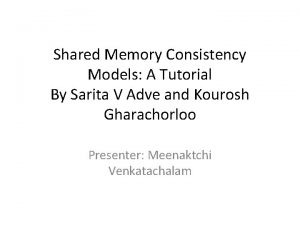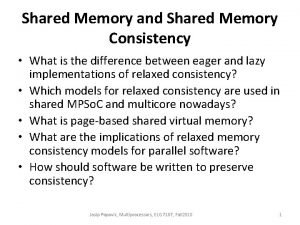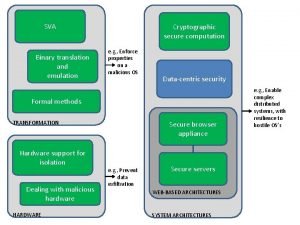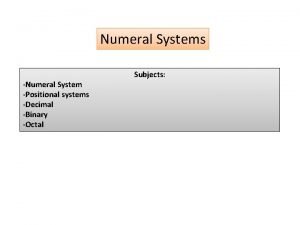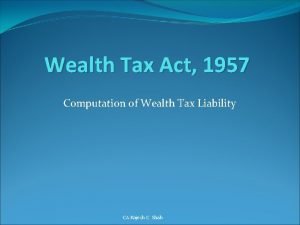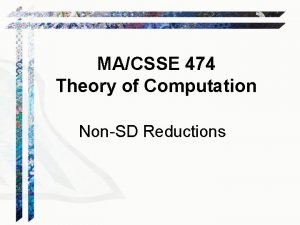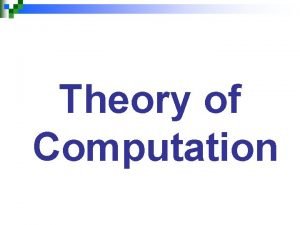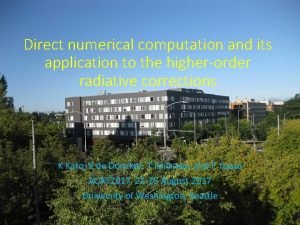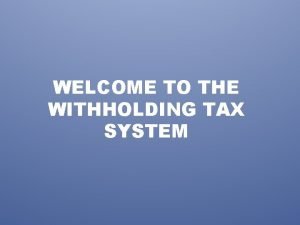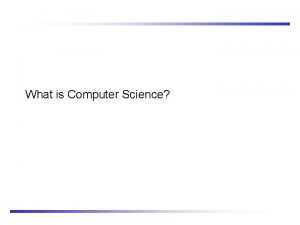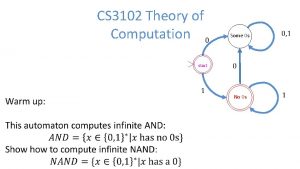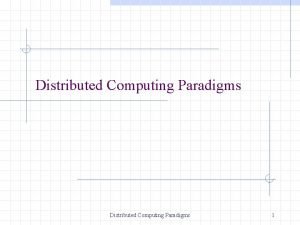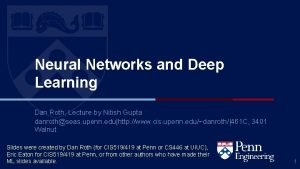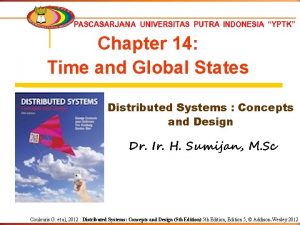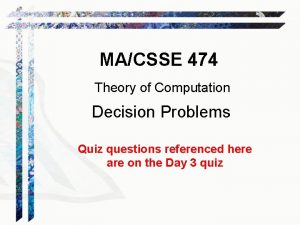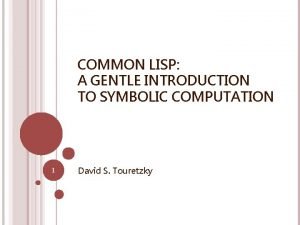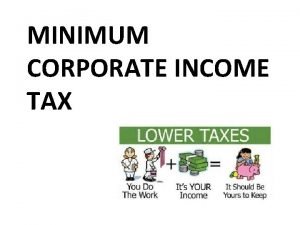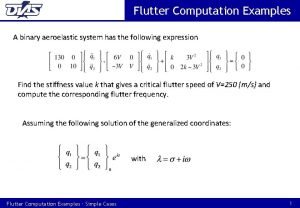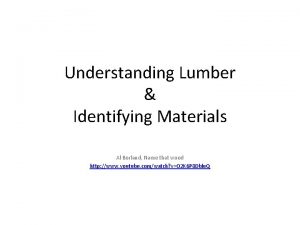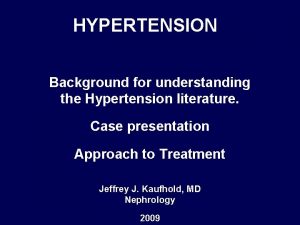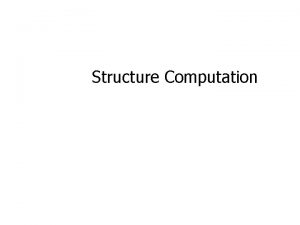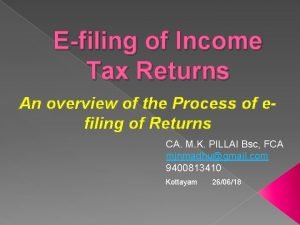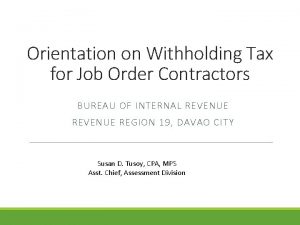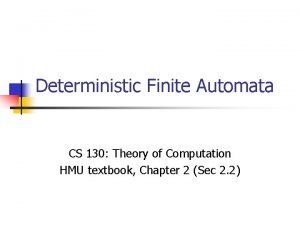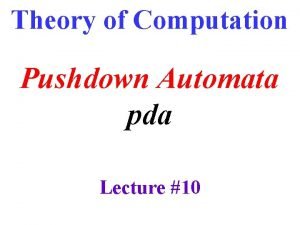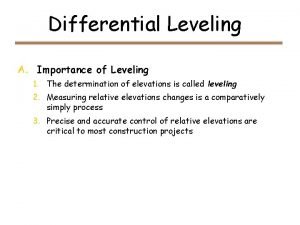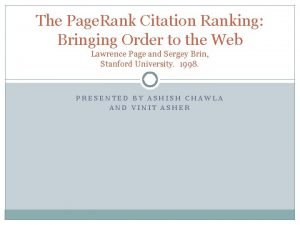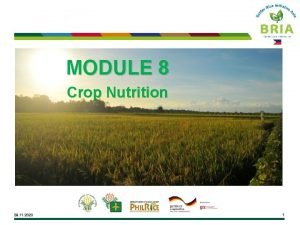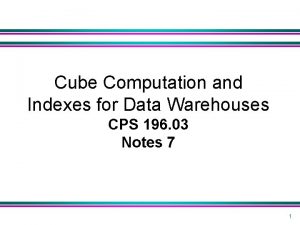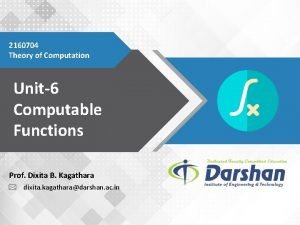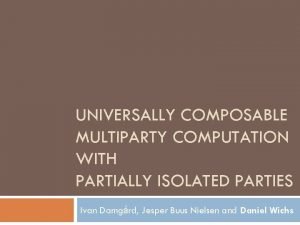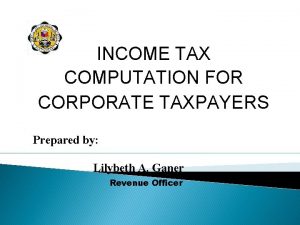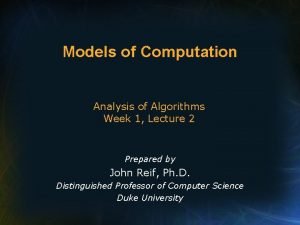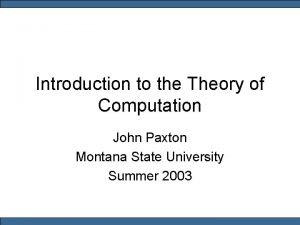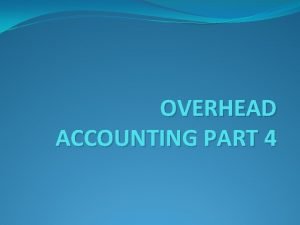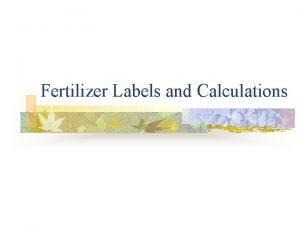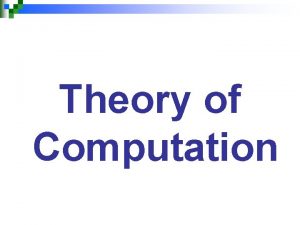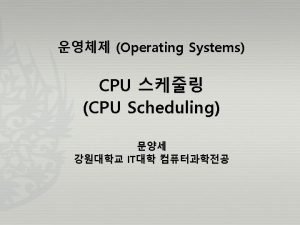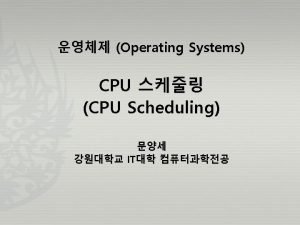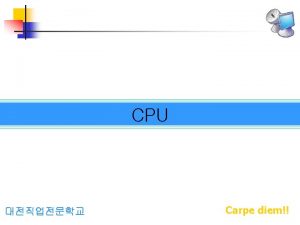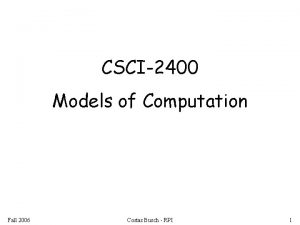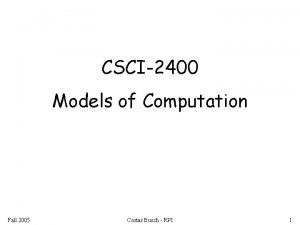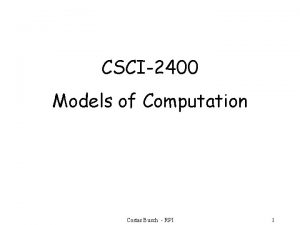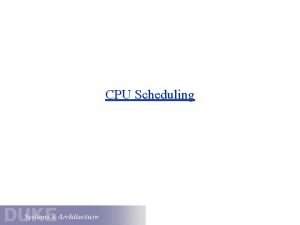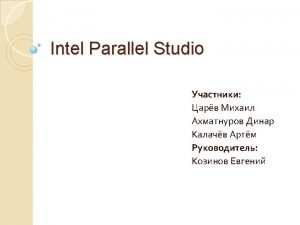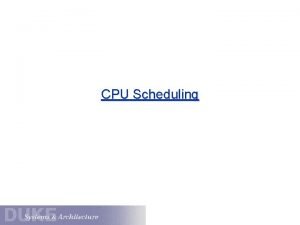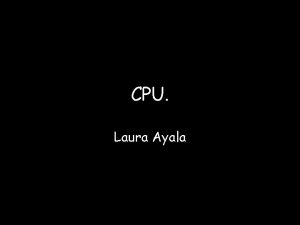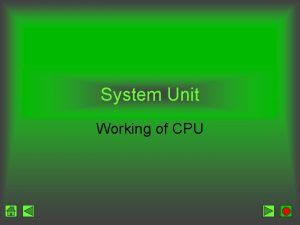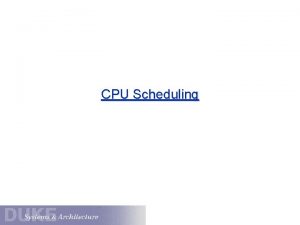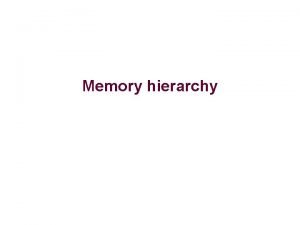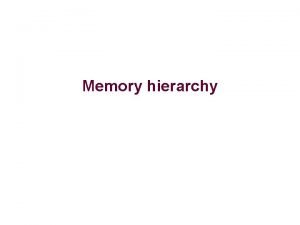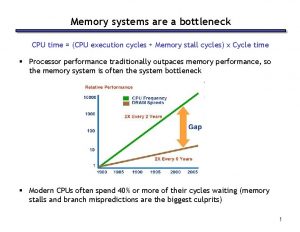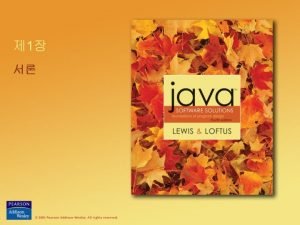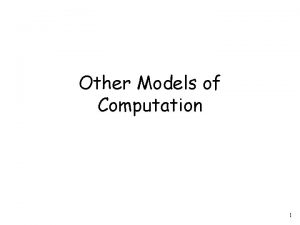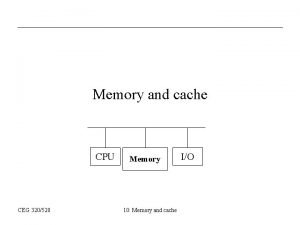CSCI2400 Models of Computation 1 Computation CPU memory


























































- Slides: 58

CSCI-2400 Models of Computation 1

Computation CPU memory 2

temporary memory input memory CPU output memory Program memory 3

Example: temporary memory input memory CPU Program memory output memory compute 4

temporary memory input memory CPU Program memory output memory compute 5

temporary memory input memory CPU Program memory output memory compute 6

temporary memory input memory CPU Program memory output memory compute 7

Automaton temporary memory Automaton input memory CPU output memory Program memory 8

Different Kinds of Automata are distinguished by the temporary memory • Finite Automata: no temporary memory • Pushdown Automata: stack • Turing Machines: random access memory 9

Finite Automaton temporary memory Finite Automaton input memory output memory Vending Machines (small computing power) 10

Pushdown Automaton Stack Pushdown Automaton Push, Pop input memory output memory Programming Languages (medium computing power) 11

Turing Machine Random Access Memory Turing Machine Algorithms input memory output memory (highest computing power) 12

Power of Automata Finite Pushdown Automata Turing Automata Machine 13

We will show later in class • How to build compilers for programming languages • Some computational problems cannot be solved • Some problems are hard to solve 14

Mathematical Preliminaries 15

Mathematical Preliminaries • Sets • Functions • Relations • Graphs • Proof Techniques 16

SETS A set is a collection of elements We write 17

Set Representations C = { a, b, c, d, e, f, g, h, i, j, k } C = { a, b, …, k } finite set S = { 2, 4, 6, … } infinite set S = { j : j > 0, and j = 2 k for some k>0 } S = { j : j is nonnegative and even } 18

A = { 1, 2, 3, 4, 5 } U A 6 1 7 10 Universal Set: 2 4 8 3 5 9 All possible elements U = { 1 , … , 10 } 19

Set Operations A = { 1, 2, 3 } B = { 2, 3, 4, 5} A • Union B A U B = { 1, 2, 3, 4, 5 } • Intersection U A B = { 2, 3 } • Difference A-B={1} B - A = { 4, 5 } A-B 20

• Complement Universal set = {1, …, 7} A = { 1, 2, 3 } 4 A = { 4, 5, 6, 7} A 1 5 A 2 6 3 7 A=A 21

{ even integers } = { odd integers } Integers 1 odd 2 3 even 0 4 5 6 7 22

De. Morgan’s Laws U AUB=A B B=AUB 23

Empty, Null Set: ={} SU =S S = U S- = Universal Set =S -S= 24

Subset A = { 1, 2, 3} B = { 1, 2, 3, 4, 5 } B U Proper Subset: A U A B B A 25

Disjoint Sets A = { 1, 2, 3 } A U A B = { 5, 6} B= B 26

Set Cardinality • For finite sets A = { 2, 5, 7 } |A| = 3 27

Powersets A powerset is a set of sets S = { a, b, c } Powerset of S = the set of all the subsets of S 2 S = { , {a}, {b}, {c}, {a, b}, {a, c}, {b, c}, {a, b, c} } Observation: | 2 S | = 2|S| ( 8 = 23 ) 28

Cartesian Product A = { 2, 4 } B = { 2, 3, 5 } A X B = { (2, 2), (2, 3), (2, 5), ( 4, 2), (4, 3), (4, 4) } |A X B| = |A| |B| Generalizes to more than two sets AXBX…XZ 29

FUNCTIONS domain range A B 1 2 3 If A = domain f(1) = a a b c f : A -> B then f is a total function otherwise f is a partial function 30

RELATIONS R = {(x 1, y 1), (x 2, y 2), (x 3, y 3), …} x i R yi e. g. if R = ‘>’: 2 > 1, 3 > 2, 3 > 1 In relations xi can be repeated 31

Equivalence Relations • Reflexive: x. Rx • Symmetric: x. Ry • Transitive: x R Y and y R z y. Rx x. Rz Example: R = ‘=‘ • x=x • x=y • x = y and y = z y=x x=z 32

Equivalence Classes For equivalence relation R equivalence class of x = {y : x R y} Example: R = { (1, 1), (2, 2), (1, 2), (2, 1), (3, 3), (4, 4), (3, 4), (4, 3) } Equivalence class of 1 = {1, 2} Equivalence class of 3 = {3, 4} 33

GRAPHS A directed graph e node a b edge d c • Nodes (Vertices) V = { a, b, c, d, e } • Edges E = { (a, b), (b, c), (c, a), (b, d), (d, c), (e, d) }34

Labeled Graph 6 a b 1 5 3 e 6 2 d c 35

Walk e b d a c Walk is a sequence of adjacent edges (e, d), (d, c), (c, a) 36

Path e b d a c Path is a walk where no edge is repeated Simple path: no node is repeated 37

Cycle a 3 e base b 2 1 d c Cycle: a walk from a node (base) to itself Simple cycle: only the base node is repeated 38

Euler Tour 8 b 4 a 7 3 6 5 base e 1 2 d c A cycle that contains each edge once 39

Hamiltonian Cycle 5 b 4 a 3 base e 1 2 d c A simple cycle that contains all nodes 40

Finding All Simple Paths e f b d a c 41

Step 1 e b f d a c (c, a) (c, e) 42

Step 2 e b d a (c, a) f c (c, a), (a, b) (c, e), (e, d) 43

Step 3 e b d a (c, a) f c (c, a), (a, b) (c, e) Repeat the same (c, e), (e, b) for each starting node (c, e), (e, d), (d, f) 44

root Trees parent leaf child Trees have no cycles 45

root Level 0 Level 1 Height 3 leaf Level 2 Level 3 46

Binary Trees 47

PROOF TECHNIQUES • Proof by induction • Proof by contradiction 48

Induction We have statements P 1, P 2, P 3, … If we know • for some k that P 1, P 2, …, Pk are true • for any n >= k that P 1, P 2, …, Pn imply Pn+1 Then Every Pi is true 49

Proof by Induction • Inductive basis Find P 1, P 2, …, Pk which are true • Inductive hypothesis Let’s assume P 1, P 2, …, Pn are true, for any n >= k • Inductive step Show that Pn+1 is true 50

Example Theorem: A binary tree of height n has at most 2 n leaves. Proof: let l(i) be the number of leaves at level i l(0) = 1 l(3) = 8 51

We want to show: l(i) <= 2 i • Inductive basis l(0) = 1 (the root node) • Inductive hypothesis Let’s assume l(i) <= 2 i for all i = 0, 1, …, n • Induction step we need to show that l(n + 1) <= 2 n+1 52

Induction Step Level n hypothesis: l(n) <= 2 n n+1 53

Induction Step Level n hypothesis: l(n) <= 2 n n+1 l(n+1) <= 2 * l(n) <= 2 * 2 n = 2 n+1 54

Remark Recursion is another thing Example of recursive function: f(n) = f(n-1) + f(n-2) f(0) = 1, f(1) = 1 55

Proof by Contradiction We want to prove that a statement P is true • we assume that P is false • then we arrive at an incorrect conclusion • therefore, statement P must be true 56

Example Theorem: is not rational Proof: Assume by contradiction that it is rational = n/m n and m have no common factors We will show that this is impossible 57

= n/m Therefore, 2 m 2 = 4 k 2 n 2 2 m 2 = n 2 is even m 2 = 2 k 2 n is even n=2 k m is even m=2 p Thus, m and n have common factor 2 Contradiction! 58
 What is the difference between models and semi modal
What is the difference between models and semi modal Shared memory consistency models a tutorial
Shared memory consistency models a tutorial Memory consistency
Memory consistency Virtual memory in memory hierarchy consists of
Virtual memory in memory hierarchy consists of Explicit memory
Explicit memory Logical address
Logical address Eidetic memory vs iconic memory
Eidetic memory vs iconic memory Long term memory vs short term memory
Long term memory vs short term memory Which memory is the actual working memory?
Which memory is the actual working memory? Shared memory vs distributed memory
Shared memory vs distributed memory Internal memory and external memory
Internal memory and external memory Virtual memory and cache memory
Virtual memory and cache memory Spreading activation psychology
Spreading activation psychology Primary memory and secondary memory
Primary memory and secondary memory Binary search in secure computation
Binary search in secure computation Octal subtraction
Octal subtraction Net maintainable rent
Net maintainable rent Computation history
Computation history Dfa to nfa
Dfa to nfa Crystalloid solution example
Crystalloid solution example Dqage
Dqage Expanded withholding tax computation
Expanded withholding tax computation Computation examples
Computation examples Theory of computation
Theory of computation Theory of computation
Theory of computation Message passing paradigm in distributed computing
Message passing paradigm in distributed computing The pagerank citation ranking: bringing order to the web
The pagerank citation ranking: bringing order to the web Computation history
Computation history Data cube computation
Data cube computation Cuts of a distributed computation
Cuts of a distributed computation Theory of computation quiz
Theory of computation quiz Sipser, m: introduction to the theory of computation
Sipser, m: introduction to the theory of computation Common lisp a gentle introduction to symbolic computation
Common lisp a gentle introduction to symbolic computation Privacy-enhancing computation
Privacy-enhancing computation What is mcit in taxation
What is mcit in taxation Computation symbols
Computation symbols Aeroelastic flutter
Aeroelastic flutter Board feet computation
Board feet computation Background
Background Computation structure
Computation structure Income tax computation format
Income tax computation format Expanded withholding tax computation
Expanded withholding tax computation Finite automata calculator
Finite automata calculator Pda vs npda
Pda vs npda Parabon computation
Parabon computation Differential leveling
Differential leveling The pagerank citation ranking: bringing order to the web
The pagerank citation ranking: bringing order to the web Fertilizer computation
Fertilizer computation Data cube computation
Data cube computation Theory of computation
Theory of computation Multiparty computation
Multiparty computation Normal tax
Normal tax Brad karp ucl
Brad karp ucl Ram model of computation
Ram model of computation The theory of computation
The theory of computation Over recovery of overheads
Over recovery of overheads Types of errors in numerical computation
Types of errors in numerical computation Fertilizer computation
Fertilizer computation Transition graph examples
Transition graph examples

